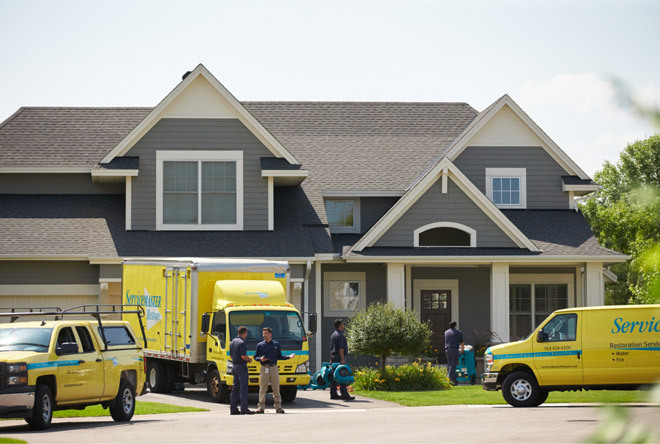Commercial Water Damage Restoration Services in Lima
Protecting Your Business from Leaks, Floods, and More
When water damage strikes your business, time is of the essence. Can you really afford to wait? The answer is a resounding no. Prompt, professional water damage restoration is crucial to preventing further damage and getting your business back on track. This is where ServiceMaster At Your Service steps in.
Our proven expertise and use of advanced technology ensure we are well-equipped to handle any water damage your business may encounter. Our team of certified professionals is always ready to respond, whether due to plumbing leaks, severe weather conditions, or other unforeseen circumstances.
Here are some of the most common causes of water damage in commercial settings:
Plumbing Leaks
These can often go unnoticed until significant damage has occurred. Our team uses advanced detection technology to identify and promptly address hidden leaks, preventing further damage.
Severe Weather Conditions
Storms and heavy rainfall can cause flooding, leading to substantial water damage. Our team is always on standby when severe weather strikes Lima, ready to provide immediate assistance and start recovery as soon as possible.
HVAC Issues
HVAC systems can lead to moisture build-up, contributing to water damage over time. We’ll address the water damage and advise on maintaining your HVAC system to prevent future incidents.
Faulty Sprinkler Systems
In commercial buildings, sprinkler systems are essential for fire safety but can cause extensive water damage when malfunctioning. Our experts can help restore your property swiftly and efficiently after such an incident.
Sewer and Drain Backups
These can cause severe water damage, including potential health hazards. Our professionals are equipped to handle these situations safely, ensuring your business environment is safe and clean.
Leveraging Advanced Restoration Technology
State-of-the-art technology allows us to accurately assess the extent of the water damage and promptly begin the restoration process. We use industrial-grade dehumidifiers, air movers, and other specialized equipment to extract water and expedite drying. This quick response minimizes the potential for mold growth and other secondary damage, saving you both time and money in the long run.
Serving Various Industries in Lima
Our restoration services cater to a wide range of commercial establishments in Lima. From retail stores and restaurants to office buildings and manufacturing facilities, no job is too big or too small for us. We understand that each business is unique and has specific needs and concerns. That's why we tailor our services to your situation, ensuring we provide the most effective and efficient solutions possible.
We also understand that water damage can disrupt your business operations, resulting in lost revenue and productivity. Our goal is to minimize this disruption as much as possible. With our 24/7 emergency service, we can respond swiftly and start the restoration process immediately, reducing the downtime your business experiences.
Contact Us Today
Why choose ServiceMaster At Your Service for your commercial water damage restoration needs in Lima? Our commitment to excellence and customer satisfaction sets us apart from the competition. With our expertise, innovative technology, and prompt response, we aim to restore your business premises and peace of mind.
Don't let water damage put your business on hold. Let us show you how we can help restore your property to its pre-loss condition and get you back to doing what you do best - running your business.
Contact us onlineor call (567) 221-3326 today for commercial water damage restoration in Lima.


